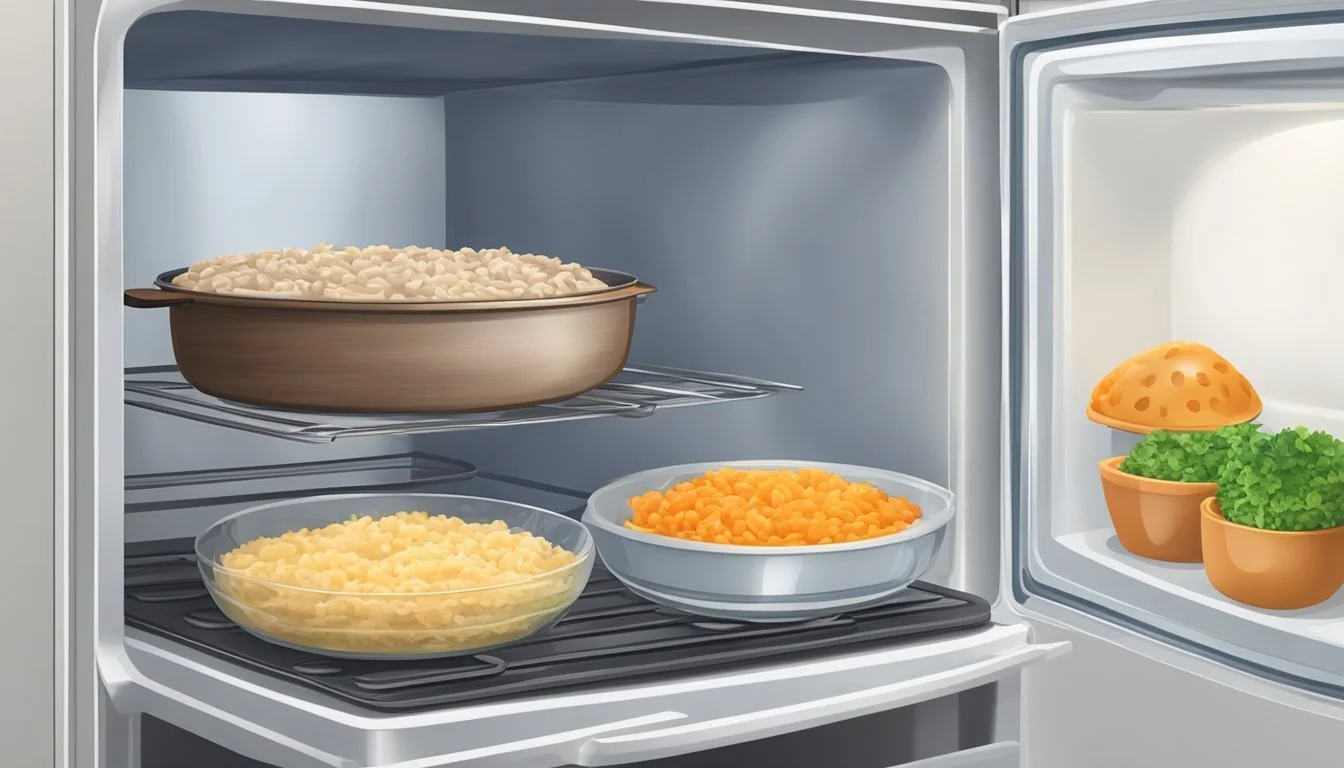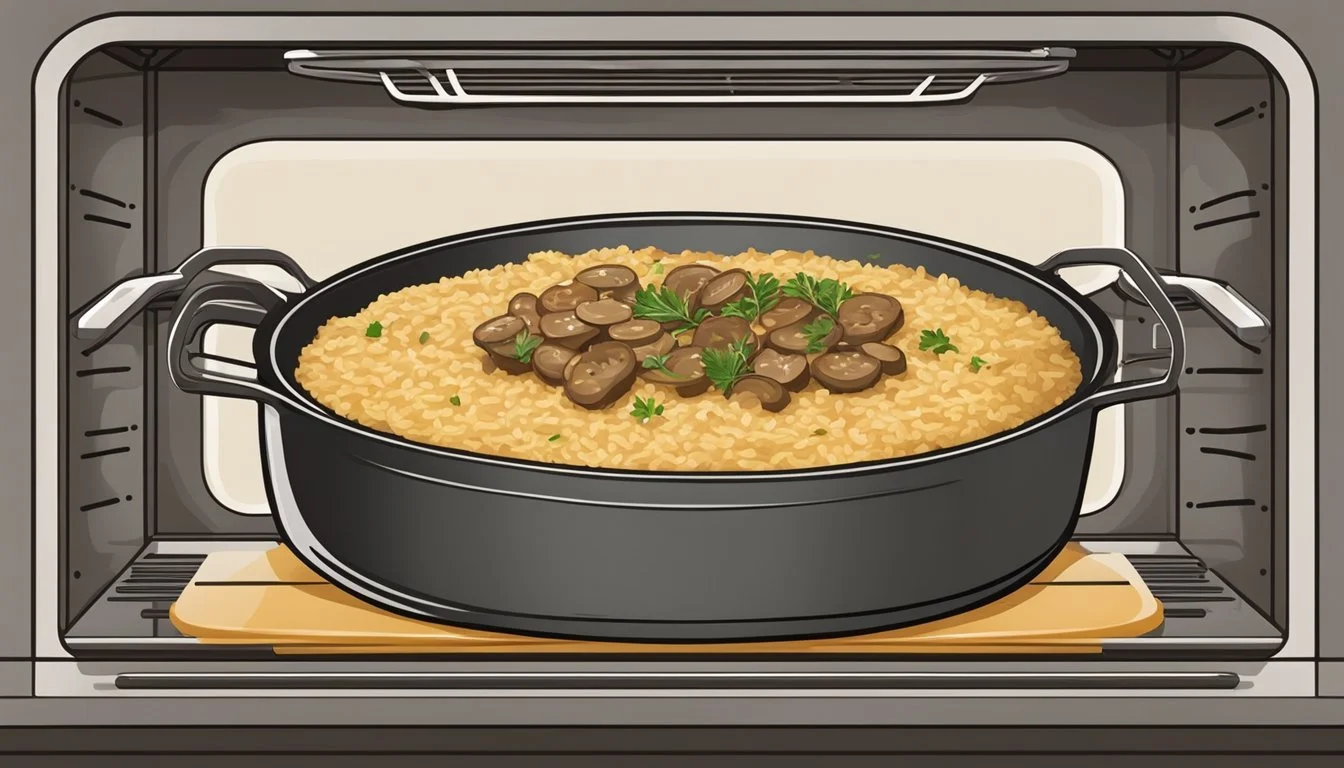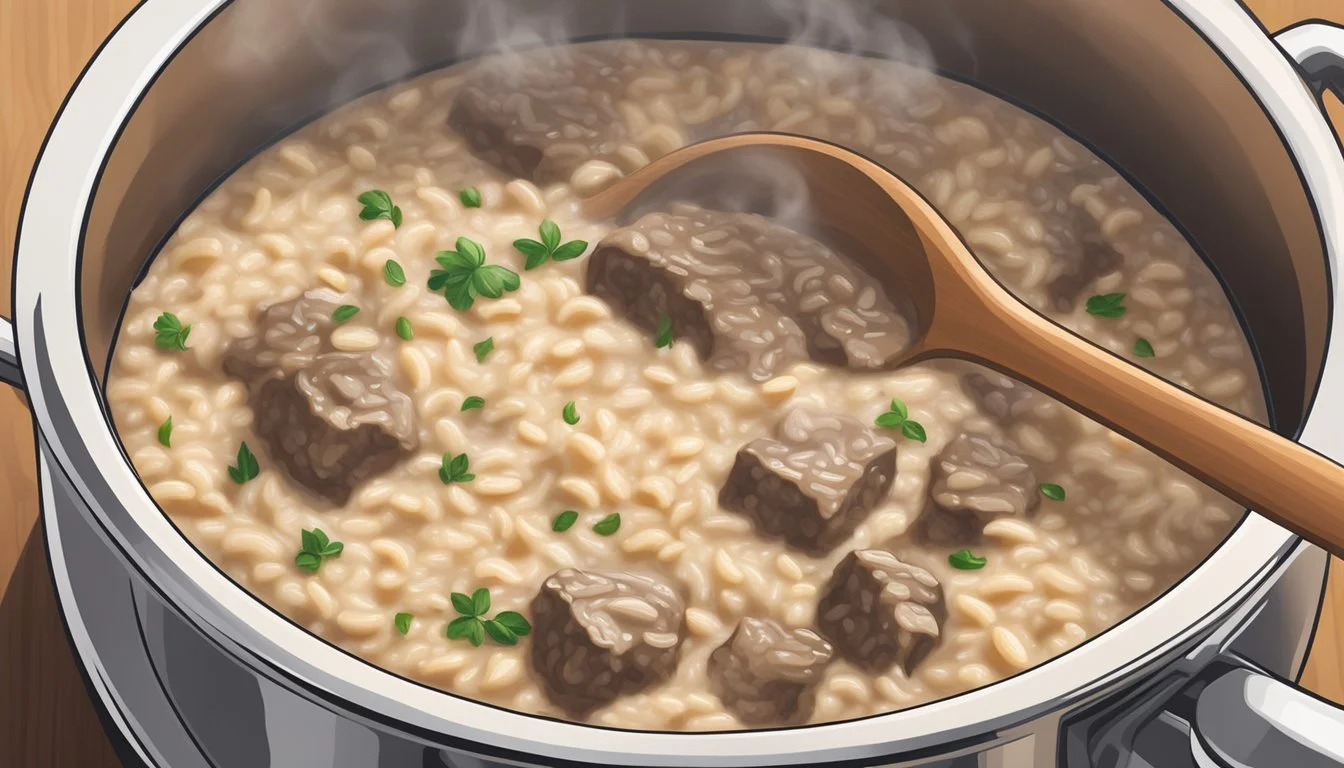How to Reheat Beef and Mushroom Risotto
Best Methods for Perfect Results
Reheating beef and mushroom risotto can be a challenging task if you want to maintain its creamy texture and rich flavors. To reheat your risotto, use methods like the oven or microwave with a splash of broth or wine to restore its luscious consistency. Whether you choose the stove, oven, or microwave, each method needs careful attention to prevent the risotto from becoming dry or overcooked.
For a quick solution, placing the risotto in the microwave with a damp paper towel can work wonders. Adding a bit of broth and stirring at regular intervals ensures the dish heats evenly and stays moist. If you have more time, reheating your risotto in the oven with a cover can give you an almost freshly-made result.
By using these simple techniques, you can bring your leftover beef and mushroom risotto back to life without compromising on taste or texture. Enjoying your favorite dish the next day can be just as satisfying as when you first made it.
Understanding Risotto
Beef and mushroom risotto combines the rich, creamy texture of traditional risotto with the savory flavors of beef and mushrooms. This section covers essential components and the best methods for reheating risotto to maintain its texture and taste.
Key Components of Mushroom Risotto
A good mushroom risotto starts with arborio rice which provides the creamy texture due to its high starch content. Essential ingredients include olive oil, butter, and parmesan cheese. Mushrooms add an earthy depth, and the optional use of white wine enhances the overall flavor.
Herbs like thyme or parsley can be included for additional flavor. The process involves constant stirring and gradual addition of broth, which is key to achieving the desired creamy consistency. Freshly grated parmesan brings a nutty taste to finalize the dish. Ensuring the right texture and balance of flavors is crucial for an authentic mushroom risotto experience.
Fundamentals of Reheating Risotto
Reheating risotto while preserving its creamy texture requires careful attention. Begin by adding a small amount of liquid such as chicken broth or vegetable broth to bring back moisture. Use a microwave-safe dish and cover it with microwave-safe plastic wrap or a damp paper towel.
Heat in 30-second intervals, stirring between each to avoid drying out. Alternatively, the oven method involves spreading the risotto in an oven-safe dish, adding a tablespoon of broth or water per cup, and covering with aluminum foil. Preheat to 300°F (150°C) and heat for 10-15 minutes. Reheating correctly keeps the risotto creamy and delicious.
Storing Leftover Risotto
Properly storing leftover risotto extends its shelf life and preserves its flavors. Essential steps include cooling, refrigerating, freezing, and reheating.
Cooling and Storing Risotto
After cooking, cooling risotto quickly is crucial to prevent bacteria growth. Spread the risotto in a thin layer on a baking sheet to cool it down within 30 minutes. Transfer it to an airtight container and refrigerate.
Key points:
Cool within 30 minutes
Use shallow containers
Store in an airtight container
For refrigeration, store the risotto within two hours of cooking. In the refrigerator, it’s good for up to 3-4 days. Always ensure the container is sealed tightly to prevent drying out and absorbing other fridge odors.
Freezing and Thawing Risotto
To extend its shelf life, freeze leftover risotto. Portion the cooled risotto into single servings and place them in airtight containers or freezer bags.
Key points:
Portion into single servings
Use airtight containers or freezer bags
Label with date
Risotto can be frozen for up to three months. When ready to use, thaw the risotto in the refrigerator overnight. Avoid thawing at room temperature to maintain its texture.
For reheating, add a splash of broth or water to restore its creamy consistency during reheating.
Preparation for Reheating
Proper preparation is crucial to ensure your beef and mushroom risotto maintains its creamy texture and rich flavor when reheated. Below are essential steps for prepping risotto before reheating.
Bringing Risotto to Room Temperature
Bringing the risotto to room temperature helps it reheat evenly. Remove the risotto from the refrigerator about 30 minutes before reheating. Spread it out on a plate or shallow dish to speed up the process.
This helps prevent it from drying out and ensures a consistent texture. Avoid reheating directly from the refrigerator, as this can lead to uneven heating and a less appetizing dish.
Adding Moisture Before Reheating
Adding moisture is vital for achieving a creamy consistency. Depending on your preference, use broth (chicken, vegetable, or beef), water, or a splash of white wine. For every cup of risotto, add about 1-2 tablespoons of liquid.
This prevents the risotto from becoming too dry during reheating. Stir the liquid in thoroughly to distribute it evenly throughout the dish.
Applying these steps will maintain the quality and taste of your beef and mushroom risotto when reheated.
Reheating Risotto on the Stove
Reheating risotto on the stove offers precise control over temperature and texture. It involves simmering over low heat and adding moisture to restore its creamy consistency.
Technique for Simmering Risotto
1. Use a Saucepan: Start by selecting a heavy-bottomed saucepan to ensure even heat distribution. Place the leftover beef and mushroom risotto in the pan.
2. Add Moisture: Add 2-3 tablespoons of broth or water per cup of risotto. This prevents the dish from drying out and helps regain its creamy texture.
3. Heat Slowly: Turn the stove to low heat. Slowly bring the risotto to a simmer, stirring occasionally. This gentle heat prevents the risotto from sticking or burning.
4. Stir Regularly: Stirring is crucial. It ensures even heating and helps incorporate the added moisture. Continue until the risotto is heated through and creamy.
5. Adjust Seasonings: Taste the risotto once heated. Adjust with additional salt, pepper, or other seasonings as needed. Serve immediately for the best texture and flavor.
Reheating Risotto in the Microwave
Reheating risotto in the microwave is the quickest and most convenient method. This technique ensures your beef and mushroom risotto remains creamy and delicious with minimal effort.
Using Microwave for Quick Reheating
First, transfer the leftover risotto to a microwave-safe dish. It's important to use a container that can handle the heat and prevent any mess.
Next, add 2-3 tablespoons of low-sodium stock or water for each cup of risotto. This liquid helps maintain the risotto’s creamy texture and prevents it from drying out.
Cover the dish with a microwave-safe lid or plastic wrap. If using plastic wrap, poke a few holes to allow steam to escape. This step is critical in retaining moisture and ensuring even heating.
Microwave the risotto on medium power for 2 minutes. Stir the risotto halfway through to ensure that the heat is evenly distributed. If necessary, add a bit more liquid and microwave for an additional 1-2 minutes until thoroughly heated.
Check the risotto’s temperature before serving. If it needs more time, heat further in 30-second intervals, stirring occasionally until it reaches the desired warmth. Adjust seasoning as needed, and enjoy your reheated beef and mushroom risotto.
Reheating Risotto in the Oven
Reheating beef and mushroom risotto in the oven ensures even heating and helps maintain a creamy texture. By using a few essential steps, you can achieve a delightful dish without compromising its quality.
Oven Method for Even Heating
To begin, preheat your oven to 300°F. This moderate temperature is ideal for slowly warming the risotto without drying it out. Place the leftover risotto in an oven-safe dish or baking pan. If it has thickened, add a splash of broth or water to help regain its creamy consistency.
Cover the dish with aluminum foil or an oven-safe lid to trap moisture and create a steaming effect. This will prevent the risotto from becoming dry and will ensure even heating.
Place the covered dish in the oven and heat for about 15 to 20 minutes. Check occasionally to ensure the risotto is heating evenly. Once heated through, give it a gentle stir before serving to evenly distribute the heat and moisture.
Alternative Reheating Methods
For those looking to rejuvenate their beef and mushroom risotto, consider these alternative reheating methods. Opt for techniques that enhance texture, such as making it crispy or adding a slight crust.
Skillet Reheating for Crispiness
To reheat beef and mushroom risotto in a skillet, start by heating a tablespoon of oil or butter over medium-high heat. Add the leftover risotto to the skillet. Spread it out evenly, allowing it to cook undisturbed for 3-5 minutes.
This method develops a crispy layer on the bottom. Stir occasionally to ensure even heating, but avoid over-stirring to maintain the crispy texture. For an added touch, consider incorporating sautéed mushrooms or a sprinkle of breadcrumbs during the last minute of heating. This will boost both flavor and texture.
Using Air Fryer for Quick Crust
Using an air fryer to reheat risotto involves creating a delicious outer crust quickly. Preheat the air fryer to 350°F. Place the risotto in a shallow, air-fryer-safe dish, ensuring it is evenly spread.
Optionally, sprinkle breadcrumbs on top for an extra crunch. Cook for about 8-10 minutes, checking halfway through. Stir gently once to ensure even heating. The air fryer provides a quick and effective way to achieve a slightly crispy exterior while keeping the risotto moist inside.
Serving Reheated Risotto
Reheated risotto can be a delightful meal when prepared correctly. Once it has been reheated, it is important to serve it in a way that maintains its creamy texture and enhances its flavor.
Sprinkling some grated cheese on top is a great way to add a rich, creamy finish. Parmesan or Pecorino work well.
To add a burst of freshness, consider garnishing with chopped parsley. This herb adds color and a slight peppery taste that complements the dish beautifully.
Salt and pepper should also be on hand to adjust seasoning to taste. Just a pinch can make a big difference.
Reheated risotto can serve as a quick lunch or a satisfying side dish. Pair it with a light salad or a piece of crusty bread to complete the meal.
For a final touch, drizzle a bit of olive oil or add a knob of butter. This will enhance the dish's richness and ensure it's comforting and flavorful.
Tips and Tricks for Best Results
To keep the creamy consistency of risotto, always add moisture before reheating. Use chicken broth, vegetable broth, or even a splash of white wine.
When using the oven, preheat to 300°F. Place the risotto in an oven-safe dish. Add a small amount of liquid and cover with aluminum foil. Heat for 15-20 minutes.
Microwave Method: Place the risotto in a microwave-safe container. Add a bit of butter or broth. Cover loosely with a lid or damp paper towel. Heat in 30-second intervals, stirring in between.
Stovetop Method: Heat a non-stick pan to medium. Add the risotto and a little liquid. Stir continuously to prevent sticking. Heat until thoroughly warmed.
Always use a safe container that's appropriate for the heating method. For the oven, choose an oven-safe dish. For the microwave, use microwave-safe containers.
For additional flavor, consider adding some freshly grated cheese just before serving. This enhances the dish's richness and creaminess.
If the risotto seems dry, add extra liquid gradually to avoid over-saturating. This helps maintain the dish's desired texture.
By following these tips, reheating beef and mushroom risotto becomes quick and efficient while preserving its delicious taste and texture.
Safety and Quality Considerations
When reheating beef and mushroom risotto, maintaining food safety and quality is crucial.
To avoid bacteria growth, ensure the risotto is heated to an internal temperature of at least 165°F (74°C). Use a food thermometer to verify this.
Leftover cooked rice should be refrigerated within two hours of cooking. Store it in shallow containers to cool quickly and evenly, reducing the risk of bacterial contamination.
When ready to reheat, consider using a paper towel or loosely covering the dish to retain moisture and prevent splatters in the microwave.
If reheating in the oven, use an oven-safe dish, covering it with a lid or aluminum foil. Adding a small amount of broth, water, or wine helps retain the risotto’s creamy texture.
Avoid letting the risotto sit at room temperature for more than two hours before reheating to minimize bacterial growth.
Following these guidelines helps ensure the risotto remains safe to eat and retains its desired quality.
Exploring Variations on Risotto
Different variations on risotto allow culinary enthusiasts to transform leftover risotto into exciting new dishes. Whether it’s crafting risotto balls or integrating unique ingredients, the possibilities are limitless.
Transforming Risotto into New Dishes
Leftover risotto can be creatively utilized to make delicious risotto balls, also known as arancini. These balls are made by shaping cold risotto into round forms, stuffing them with cheese or meat, and then breading and frying them to create a crispy exterior.
Additionally, exploring diverse recipes, such as butternut squash risotto, can introduce new flavors and textures. Butternut squash imparts a sweet and nutty taste, complementing the creamy consistency of the risotto.
Transforming risotto maximizes the uses of this savory dish, offering both versatility and flavor.









